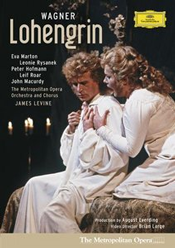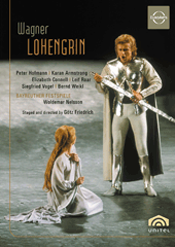This doesn’t mean that ‘the next swan’ puts in an appearance in the Everding production at the Met ( brilliant lighting does the job) but the designs and costumes transfer us to Antwerp in the early middle ages. Exact dating of the opera is even possible: between 919 and 936, as those were the years Heinrich der Vögler was German king (though to be honest, the duchy of Brabant, where this reviewer is living, only got its name some 150 years later). Anyway, the Met production’s sets and costumes are roughly apt for the period and Elsa at least, wears some robes fit for a duke’s daughter instead of the same ugly colourless night gown Friedrich and his team thought fit for the Bayreuth production. Peter Hofmann too looks far better in his fine Met costumes than in the now hopelessly dated half knight/ half astronaut plastic (or is it metal ?) he has to wear in Germany. Friedrich probably had some ‘democratic’ problems with the king being graciously attended to, and so he has the singer seated on the steps of the stairs among all the other nobles. At the Met the king gets his throne during his hearing and the scene all at once doesn’t look ridiculous anymore. Time and again one sighs at Friedrich’s solutions and with relief one returns to Everding.
The Bayreuth production, however, has one distinct advantage over the Met’s. Four years and a lot of heavy Wagner roles later have taken their toll on Hofmann’s voice. The shine of it has somewhat disappeared and there is more strain in the high register. Granted, there is more refinement and some fine piannismi phrasing too at the Met, but these don’t quite compensate for the loss of vocal strength. This doesn’t mean the Bayreuth performance is perfect. After all this is Wagner’s most Italian opera and the recordings of De Lucia and Pertile prove what an Italian tenor could do with it. I sorely miss the ‘morbidezza’, the sweetness and sensuality, a good tenor can bring to the role, and next to Sandor Konya, Hofmann pales. Leif Roar too has not improved in the few years between the two recordings. In Bayreuth he is an impressive Telramund and he sings with the dark-burnished sound apt for the role. At the Met his singing is often crude and soon becomes barking before degenerating into shouting. Siegfried Vogel too at Bayreuth is vocally more impressive than the Met’s John Macurdy, who has some flat notes. Both Bernd Weikl and Anthony Raffell (a name unknown to me) sing a sturdy and strong Heerrufer. I don’t think nowadays both houses are still able to cast this small role with such outstanding talent.
On the ladies front, however, the Met wins hands down. Karan Armstrong is rather passive and colourless compared with the bigger and more creamy sound of Eva Marton. Elisabeth Connell is a South-African soprano and therefore can more easily cope with the high tessitura of the role but she is no match for the acting and the rich secure top of Leonie Rysanek, stunning at age 60.Woldemar Nelsson is a solid Kapellmeister but already at the prelude there is an aura of magic lacking. James Levine, with his long experience in German and especially Italian opera, immediately plunges into the mystery of the score and keeps it up till the end of the opera. The Met’s orchestra and chorus too are on the same level as the Bayreuth phalanx. As often one wishes one could take the best of these two worlds but in the end Levine, Marton and the production give the Met’s performance a slight edge.
Jan Neckers
 |  |
| Click image to buy | Click image to buy |


